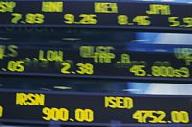
 |
|
| Financial Terms | |
| Shareholders’ funds |
|
Information about financial, finance, business, accounting, payroll, inventory, investment, money, inventory control, stock trading, financial advisor, tax advisor, credit.
Main Page: finance, business, inventory control, financial advisor, credit, money, payroll, stock trading, |
Definition of Shareholders’ funds
Shareholders’ fundsThe capital invested in a business by the shareholders, including retained profits.
Related Terms:Beta (Mutual Funds)The measure of a fund's or stocks risk in relation to the market. A beta of 0.7 means Beta equation (Mutual Funds)The beta of a fund is determined as follows: Cost of fundsInterest rate associated with borrowing money. Dividend yield (Funds)Indicated yield represents return on a share of a mutual fund held over the past 12 Endowment fundsInvestment funds established for the support of institutions such as colleges, private Federal fundsNon-interest bearing deposits held in reserve for depository institutions at their district Federal Federal funds marketThe market where banks can borrow or lend reserves, allowing banks temporarily  Federal funds rateThis is the interest rate that banks with excess reserves at a Federal Reserve district bank Forward Fed fundsFed funds traded for future delivery. Funds From Operations (FFO)Used by real estate and other investment trusts to define the cash flow from Shareholders' equityThis is a company's total assets minus total liabilities. A company's net worth is the Shareholders' letterA section of an annual report where one can find jargon-free discussions by Surplus fundsCash flow available after payment of taxes in the project. Term Fed FundsFed funds sold for a period of time longer than overnight. 12b-1 fundsMutual funds that do not charge an upfront or back-end commission, but instead take out up to Shareholders' equityThe total amount of contributed capital and retained earnings; synonymous with stockholders' equity.  internally generated fundsCash reinvested in the firm; depreciation plus earnings not paid out as dividends. Federal Funds RateThe interest rate at which banks lend deposits at the Federal Reserve to one another overnight. Shareholders' EquityThe residual interest or owners' claims on the assets of a corporation Labour-Sponsored Venture FundsVenture capital corporations established by labour unions. They function as other venture capital corporations but are subject to government regulation. EFT (electronic funds transfer)funds which are electronically credited to your account (e.g. direct deposit), or electronically debited from your account on an ongoing basis (e.g. a pre-authorized monthly bill payment, or a monthly loan or mortgage payment). A wire transfer is a form of EFT. growth fundsMutual funds that seek long-term capital growth. This type of fund invests primarily in equity securities. income fundsMutual funds that seek regular income. This type of fund invests primarily in government, corporate and other types of bonds, debt securities, and other income producing securities and in certain circumstances can also hold common and preferred shares. index fundsMutual funds that aim to track the performance of a specific stock or bond index. This process is also referred to as indexing and passive management. NSF (non-sufficient funds)This appears on your statement if there are insufficient funds in your account to cover a cheque that you have written or a pre-authorized payment that you have already arranged. You will be charged a service fee for non-sufficient funds. savings fundsMutual funds that seek to preserve capital. This type of fund invests primarily in short-term securities with an average term to maturity of one year or less, or in the case of money market funds, 90 days or less. Annual fund operating expensesFor investment companies, the management fee and "other expenses," DistributionsPayments from fund or corporate cash flow. May include dividends from earnings, capital Expense ratioThe percentage of the assets that were spent to run a mutual fund (as of the last annual Rights offeringIssuance of "rights" to current shareholders allowing them to purchase additional shares, Equityfunds raised from shareholders. GearingA measure of the extent of long-term debt in comparison with shareholders’ funds. Return on capital employed (ROCE)The operating profit before interest and tax as a percentage of the total shareholders’ funds plus Related to : financial, finance, business, accounting, payroll, inventory, investment, money, inventory control, stock trading, financial advisor, tax advisor, credit. |